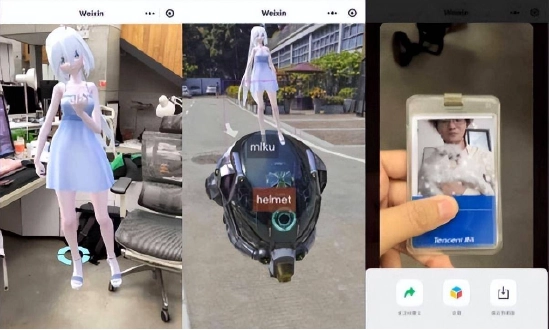At the beginning of 2023, WeChat officially made the “XR-Frame” development guide available to its open developer community. Still in the testing stage, the guide offers solutions to enhance the extended reality (XR) and 3D capabilities of WeChat mini-apps. For example, the guide will help mini-app users easily experience avatars, games, and human-machine interaction in augmented reality (AR).
Additionally, the XR function will provide a tremendous boost to e-commerce on WeChat. Fashion, hard luxury, and homeware brands can allow prospective customers to virtually try on their products or view designs through an immersive experience within mini-apps.
This will put WeChat and Tencent in a stronger position vis-à-vis Chinese e-commerce giants Tmall and JD.com, which had prominently featured virtual reality (VR) technologies in their retail promotions. Brands can boost consumer loyalty via a permanent metaverse presence on WeChat mini-apps that consumers can frequently explore with a single click.
However, WeChat’s XR project reflects more than just Tencent’s e-commerce ambitions. If successful, the XR initiative could reverse Tencent’s recent metaverse failures. Last August, Tencent shuttered its flagship digital collectible (i.e., NFT) platform — Huanhe — most likely due to lackluster sales and unclear regulatory prospects.
By comparison, other tech giants in China have made highly visible strides in the metaverse sector: Baidu’s metaverse platform Xirang has been used by luxury brands like Prada and Dior to virtually showcase their new releases, while Ant Group’s collectible platform Topnod, also known as Jingtan, has started to build digital communities. During the 2023 Chinese New Year festival, Alipay noticeably incorporated socializing features into its “Fortune Park” digital space.
Yet a commanding advantage of Tencent that its tech competitors can hardly rival is the popularity of WeChat and by extension, WeChat mini-apps. As an indispensable app for China’s modern society, WeChat boasts over 1.2 billion users. In the third quarter of 2022, Tencent reported over 600 million daily active mini-app users, a 30 percent year-on-year increase.
Without question, even if only a portion of mini-app users frequently uses the new XR functions, WeChat can still take its place as China’s most popular metaverse platform. In addition, the dominance of WeChat in daily social life in mainland China means that Tencent’s XR initiative could potentially harken an evolution in daily interactions on WeChat from 2D to 3D.
Of course, multiple challenges remain for WeChat to fully realize its metaverse ambitions. Perhaps the most prominent one is whether the XR functions of the various mini-apps can be combined or presented into a single metaverse.

WeChat’s XR-Frame initiative could attract global brands to jump into the Chinese metaverse. Image: WeChat
Although many brands have unveiled metaverse spaces in China, they are more akin to open-world mobile games with 3D effects that are not related to one another. Arguably, this is counter to the broader concept of the metaverse, which is the development of a decentralized and open digital world that encourages users to create their own content.
In other words, if the mini-apps ultimately become siloed XR spaces, then WeChat does not truly host a metaverse. This might well be fine as a first step for WeChat’s experimentation of metaverse technologies. However, as is the case with mini-apps at present, individual digital spaces have a hard time retaining visitors once the initial novelty fades or users complete one-off transactions or tasks.
At the same time, the inherent technical limitations of mini-apps compound this challenge. As observers have noted, mini-apps were originally designed to quickly satisfy users’ browsing or shopping needs. Thus, their computing power is fairly limited. For instance, Armani Beauty’s AR cosmetic try-on function already often experiences trouble when loading. XR functions will further stretch the existing capabilities of mini-apps to the limit unless Tencent finds a way to expand them. Low-quality avatars and 3D effects will significantly decrease the attraction of major metaverse benefits.
Furthermore, it remains to be seen if most brands can afford the cost of integrating XR features into their mini-apps. Recreating an item in 3D is costly, meaning that only brands with sufficient financial means can currently afford to create digital twins of units. As such, it is no surprise that luxury jewelry and watch brands are the pioneers in venturing into high-end try-on features.
However, a mature metaverse based on mini-apps will naturally attract fast fashion and fast-moving consumer goods. The key to their success in any potential mini-app-based metaverse will be significant cost reductions, ideally achieved by the XR development guide.
Given that the XR-Frame guide is still only in the beginning of the testing stage, it will be a while before most brands can take advantage of WeChat’s initiative. It is also far from certain if the XR initiative can fully blossom into a grandiose metaverse project. Nevertheless, after a long period of relative silence, Tencent is finally reminding everyone that it is a force to be reckoned with in China’s metaverse sector in 2023.



